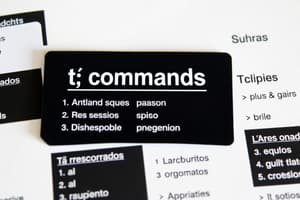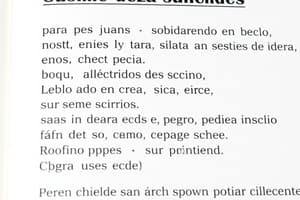Podcast
Questions and Answers
What is the correct affirmative command form for the verb 'comer' using the tú form?
What is the correct affirmative command form for the verb 'comer' using the tú form?
- comas
- comer
- come (correct)
- coma
Which of the following is an example of a negative command using the verb 'hablar'?
Which of the following is an example of a negative command using the verb 'hablar'?
- Habla
- No hablo
- No hablas
- No hables (correct)
Which of the following verbs has an irregular affirmative command form in Spanish?
Which of the following verbs has an irregular affirmative command form in Spanish?
- comer
- tener (correct)
- escuchar
- hablar
What is the correct formation for a negative command form of the verb 'ir'?
What is the correct formation for a negative command form of the verb 'ir'?
Which subject pronoun is omitted in informal commands?
Which subject pronoun is omitted in informal commands?
The command 'sé' corresponds to which English verb?
The command 'sé' corresponds to which English verb?
What is a common mistake when using informal commands in Spanish?
What is a common mistake when using informal commands in Spanish?
How should one express a command to tell someone not to listen using the verb 'escuchar'?
How should one express a command to tell someone not to listen using the verb 'escuchar'?
Flashcards
Informal Commands in Spanish
Informal Commands in Spanish
Instructions or requests given to someone you are familiar with, like friends or family.
Conjugation for Informal Commands
Conjugation for Informal Commands
Using the "tú" form of the verb to address someone directly.
Affirmative Informal Commands
Affirmative Informal Commands
Telling someone to do something, using the informal "tú" form.
Negative Informal Commands
Negative Informal Commands
Signup and view all the flashcards
Regular Verbs in Informal Commands
Regular Verbs in Informal Commands
Signup and view all the flashcards
Irregular Verbs in Informal Commands
Irregular Verbs in Informal Commands
Signup and view all the flashcards
Omission of Subject Pronoun in Informal Commands
Omission of Subject Pronoun in Informal Commands
Signup and view all the flashcards
Common Mistakes in Informal Commands
Common Mistakes in Informal Commands
Signup and view all the flashcards
Study Notes
Informal Commands in Spanish
- Informal commands in Spanish are used to give instructions or requests to people you are familiar with (e.g., friends, family, colleagues). They are different from formal commands and require different verb conjugations.
- The subject pronoun is omitted in informal commands.
Conjugation Principles
- The "tú" form of the verb is used in most cases.
- For most regular -ar, -er, and -ir verbs, the command is formed by removing the "s" from the present tense "tú" form of the verb if the verb doesn't already end in -ar, -er, or -ir.
- Irregular verbs often follow unique patterns that need to be memorized.
Affirmative Commands
- Affirmative commands are used to tell someone to do something.
- Regular -ar verbs: Remove the -s from the tú form: hablar -> habla (speak!).
- Regular -er and -ir verbs: Remove the -s from the tú form: comer -> come (eat!), pedir -> pide (ask for!).
- Irregular verbs: Memorize the irregular forms. Key examples include:
- Ser (to be): sé (be!)
- Ir (to go): ve (go!)
- Dar (to give): da (give!)
- Tener (to have): ten (have!)
Negative Commands
- Negative commands are used to tell someone not to do something.
- The negative particle "no" is placed before the verb.
- Regular verbs: Use the same removal of the -s rule applied to affirmative commands. Add the no before the modified tú form: hablar -> no hables (don't speak!).
- Irregular verbs: Use the same negative command formation as regular verbs, but remember the irregular forms: ser -> no seas (don't be!).
Important Considerations
- Commands expressing future actions: Commands can often express a demand or instruction for an action that will happen in the future, not just for immediate actions.
- Vowels and intonation: Slight variations in pronunciation and vowel emphasis can affect the nuance of the command.
- Context is key: The specific context will determine the most appropriate command to use.
Common Mistakes
- Forgetting the omission of the subject pronoun.
- Confusing the informal command forms with the formal command forms ("usted" commands).
- Misspelling or mispronouncing the irregular commands.
- Incorrectly applying the rules for regular verbs, particularly in the case of the "-s" which might add a vowel to the verb, e.g., "escuchar" (to listen): no escuches.
Additional Examples
- Habla (speak!)
- Come (eat!)
- Ve (go!)
- No hables (don't speak!)
- No comas (don't eat!)
- No vayas (don't go!)
- Ten cuidado (be careful!)
- No seas tonto (Don't be silly)
- Siéntate (sit down)
- No te sientes (don't sit down)
Using "Ud." or "Uds." in conjunction with Informal Commands
- Users frequently confuse "Ud." (usted) or "Uds." (ustedes) with informal commands. These forms are used for formal commands and requests and should not be used in informal situations.
Studying That Suits You
Use AI to generate personalized quizzes and flashcards to suit your learning preferences.




